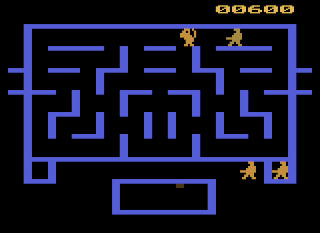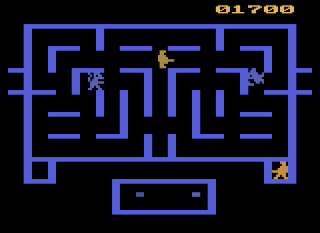|
|
Wizard of Wor
|
Name:
|
Wizard of Wor |
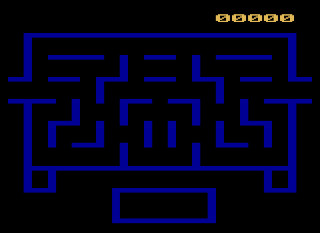 |
| Company: | CBS | |
|
Model #:
|
80000 | |
|
Programmer:
|
Joe Hellesen |
|
| Year: | 1982 | |
|
Released?
|
Yes
|
|
|
Notes:
|
Port of the 1980
Midway Coin-Op |
Port of the 1980 Midway Coin-Op, Wizard of Wor was one of the
first arcade games to feature voice synthesis during the
game. The voice (that of the titular Wizard of Wor) taunts
players with various phrases which were probably post to sound
menacing, but sounds more like the computer from Wargames with
some sass. Still, it's of the most recognizable arcade
voices this side of Berzerk. Oh, and in case you're
wondering, it was Taito's Stratovox that was truly the first
arcade game with voice synthesis. Stratovox beat Wizard of
Wor to the punch by a few months.
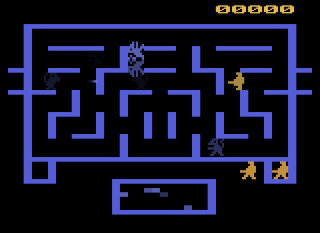
The goal of Wizard of Wor is to work your way through the various dungeon levels and destroy the Wizard himself. Each dungeon appears as a series of walls which for a open maze through which you must traverse. Each maze is a bit different, with some being wide open (pit levels) and some having convenient tunnels for hiding. Finding a safe place to hold up and shoot is essential as the monsters can come at you from any direction and like to turn invisible a the higher levels. Speaking of monsters, let's introduce them now.
Each level starts with blue wolf looking creatures called Burwors. Killing a Burwor will cause it to be replaced by yellow creature called a Garwor (how quickly depends on the level). Killing all the Garwors will cause a red scorpion like creatures called a Thorwor to appear. Killing all the Thorwors will cause Worluk to appear. Worluk is a bit different from the other monsters in that he won't actually fight you, but rather tries to escape through one of the dungeon exits. If you manage to shoot Worluk he's worth a lot of points. Once Worluk is dead or escapes, there's a chance that the Wizard of Wor himself will appear. The Wizard likes to teleport all over the dungeon shooting you with his fast lightning bolts. Killing the Wizard is more a matter of luck than skill.
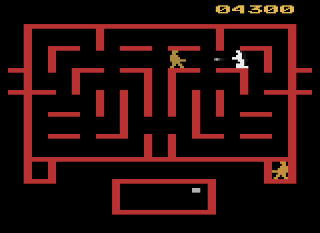
So with all these monsters roaming the dungeon, how on earth are
you supposed to keep track of them all, especially given that they
can turn invisible? Your secret weapon is the radar scanner
at the bottom of the screen. The radar shows the locations
of all the monsters in the current dungeon, both visible and
invisible. It also shows the locations of Worluk and the
Wizard of Wor himself (if he's in the dungeon). Watching the
radar is essential or you just might find an invisible monster
sneaking up on you.
One of Wizard of Wor's best features is that it features
simultaneous two player action. You and friend can either
team up to wipe out the Wizard, or you can choose to fight each
other. As each player's shots can kill the other player, it
is recommended that you either stay on different parts of the
dungeon or use the back-to-back strategy to keep from accidentally
shooting each other (although that will happen eventually
regardless).
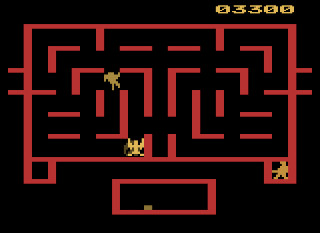
So how does the Atari 2600 version of Wizard of Wor stack up? Surprisingly well! While it's missing the voice samples (as to be expected) it has most of the music, and manages to look similar to the arcade version. One of the first thing you'll undoubtedly notice upon firing up Wizard of Wor is that you can't seem to move your player. Puzzled you look at your joystick port, yes it's plugged in, so why isn't it working? Congratulations, you've just fallen prey to one of the oddest quirks about Wizard of Wor. Unlike the 99.9% of other Atari 2600 games, Wizard of Wor uses the right joystick port for player one and the left port for player two. The reason for this is simple, it's because that's how the arcade version was. Why did the arcade game have this weird arrangement? No one seems to know, but it probably lead to a lot of perfectly good carts being returned as defective. Of course the manual mentions to use the right port, but who reads manuals?
| Version | Cart Text | Description |
| ?/??/82 | Late beta | |
| ?/??/82 | PAL VCS Wiz |
Final (PAL) |

